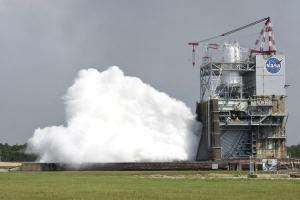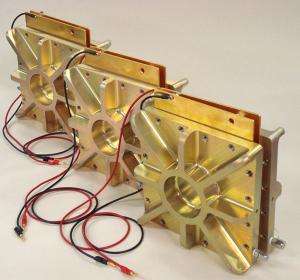Using proton-exchange-membrane fuel cells to recover high-purity helium

The University of Hawai'i at Mānoa's Hawaiʻi Natural Energy Institute (HNEI), together with Sierra Lobo Inc., has demonstrated the recovery of high-purity helium from hydrogen/helium mixtures produced at rocket engine testing sites using proton-exchange-membrane fuel cells.
The National Aeronautics and Space Administration (NASA) uses a large amount of helium gas—about a million cubic feet per launch to purge hydrogen from their fuel lines. Helium gas, contaminated with hydrogen, is expensive and energy-intensive to purify and recover. Capitalizing on expertise at HNEI, Sierra Lobo technologists challenged the team to use proven fuel cell technology to develop an efficient recycling process for helium.
"HNEI optimized proton-exchange-membrane fuel cell (PEMFC) technology to electrochemically separate the two gases," explained Richard Rocheleau, HNEI's Director. Separation was achieved by applying electrical energy to the fuel cell, rather than using it to produce energy.
"Fuel cell technology is an excellent choice for separating the helium from hydrogen-helium mixtures," said Mike Angelo, project manager from HNEI. "The fuel cell uses a catalytic reaction and membrane transport to remove the hydrogen, allowing for the efficient recovery of very high purity helium."

In laboratory experiments, HNEI demonstrated that contaminated gas streams with up to 50% hydrogen can be refined to produce 99.995% pure helium. A pilot-scale Helium Reclamation System was designed and built by Sierra Lobo and its performance was validated on-site at the NASA Stennis Space Center in Mississippi.
"Sierra Lobo combines advanced engineering services with developing, manufacturing, and marketing new and enhanced products and processes for the aerospace, transportation, and energy industries," said Sierra Lobo President and CEO George Satornino. "This project gave us the perfect opportunity to leverage our engineering know-how with HNEI's fuel cell expertise to develop a unique prototype turnkey system, tailored to NASA's needs."
HNEI developed a chemical reactor model to estimate the PEMFC size needed to attain a specific helium purity for different hydrogen concentrations and processing rates. The model was used by Sierra Lobo to size fuel cell technology used in the pilot-scale separation system.

Development and initial testing was conducted at HNEIs' Hawai'i Sustainable Energy Research Facility (Hi-SERF), formerly known as the Hawai'i Fuel Cell Test Facility, a state-of-the-art laboratory specializing in PEMFCs and battery testing. Located within a secured area on Hawaiian Electric Company (HECO) property in downtown Honolulu, this 4,000-square-foot facility currently houses an extensive array of cutting-edge equipment to test fuel cell materials, fuel cells and cell stacks, and compact fuel cell systems (up to 5 kW). More recently, HiSERF has expanded its focus to include battery energy storage systems in support of HNEI's grid-scale storage projects conducted in collaboration with HECO.
Although helium is relatively rare, its commercial applications are extensive. Helium's uses vary widely—from cryogenics, to superconducting magnets, to growing crystals for semiconductors, to hospital MRI use. Starting with NASA's interest in helium recovery, this project has promising implications worldwide.
Provided by University of Hawaii at Manoa





















